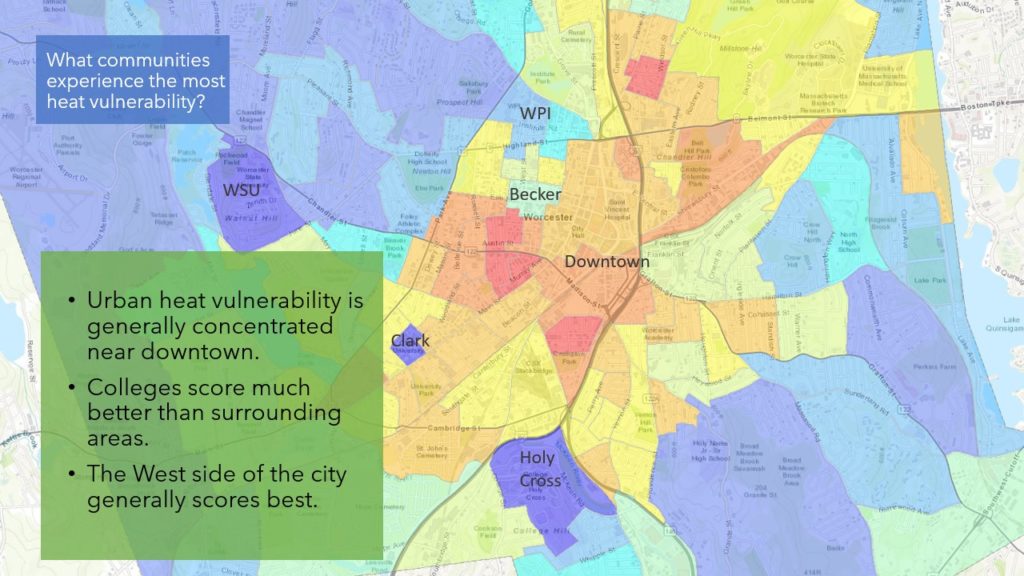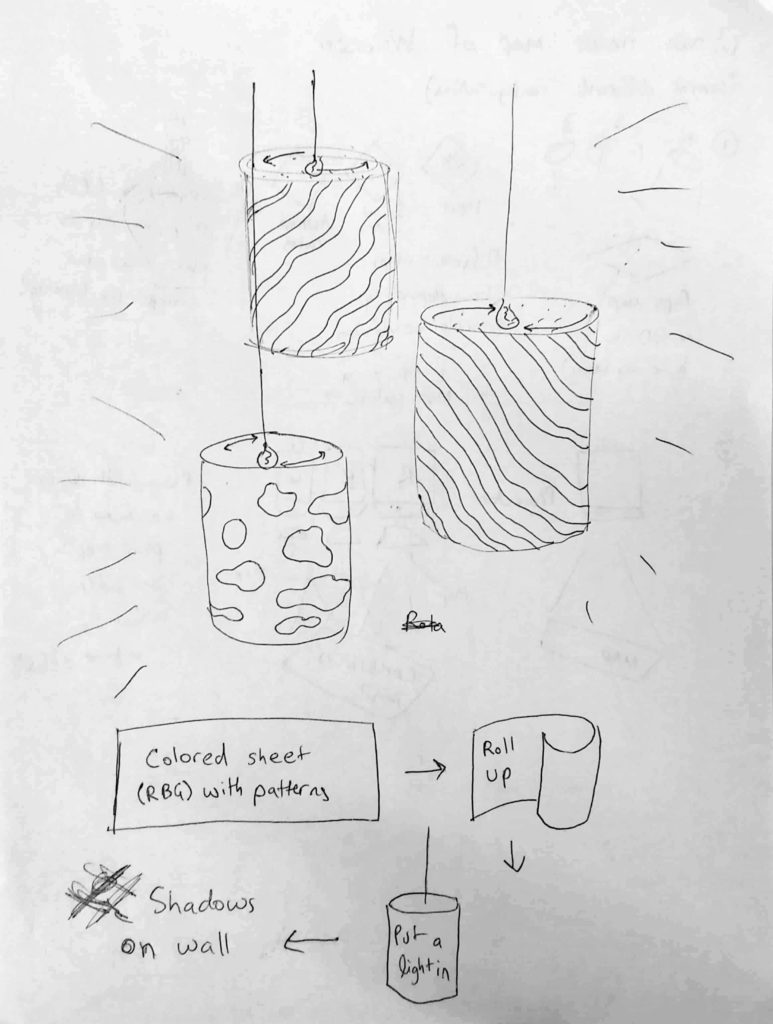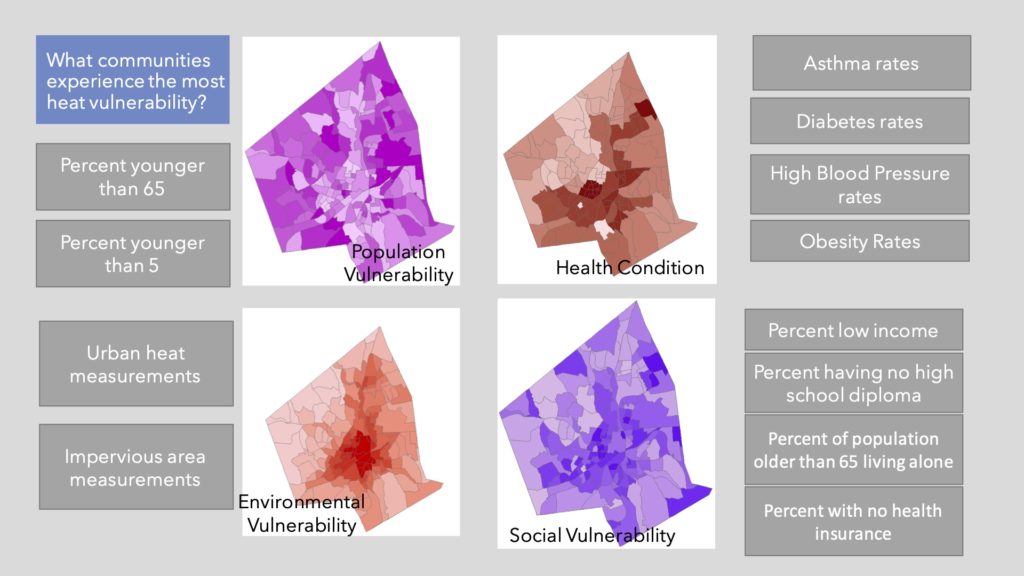Idea 1: Some Swirly Shadows (SSS).
Basically, I will make 3 patterned sheets, roll them into a cylinder, and put a light inside them. They will be rotating and casting shadows around them. The shadows are of different colors: either the sheets with the patterns are colored, or the lights themselves are colored (and can maybe change colors — fancy!). The lights will have to be small to cast fine shadows.
So what patterns are there? I’m thinking it would be an optical illusion sort of trippy pattern, but if I draw details that come out with the light, I could draw stories, motifs or emblems to put more meaning into it. This is something I will have to see if it works and doodle more about.
I am thinking I could make this more interactive by having the patterns be extremely detailed but they cover up each other, and each individual participant can shine a spotlight around on the multicolored shadows to reveal details, or block parts using their own body.
I could also attach sensors the motors that spin the sheets to make the shadows move, for example, they spin faster when people speak more or move more. That would be an interesting idea.
Artist questions:
What are some ideas about lights and motors? Colored lights or colored paper?
Is it concerning that the shadows might be projected on irregular walls? Is there a way I can integrate the irregular walls as part of the art piece?
Are there ways I can make the art piece interactive?
Idea 2: Participatory Urban Planning (PUP).

I will print out or display a map of Worcester, MA, with a combined map of asthma rates, high summertime temperatures, and demographics (such as elderly people and minority populations), and print each of them in a different color. When you shine different colored lights on them, you will be able to see each map separately, then you can shine a white light and see them all combined.
Earlier I was thinking I would project the maps somehow, but printing it out would be much easier.
I could also 3D print a map of the buildings in Worcester, and color them somehow. Do people have thoughts on this? (I think one person earlier does that sort of thing)
I am imaging that participants will interact with the map. For example, planting ‘LED’ trees on the map to change the lighting of the map and cool the city down, or by putting in new buildings and seeing how they might change the map.
This idea is probably not very easy, but I like it because urban planning tends to be caught up in legalities of zoning laws and in general is not connected to people who live in the area — I think art could bridge the gap!
Artist questions:
I’m thinking the easiest way would be to print out the map or 3D print the buildings and color them similarly to the map. If I use the 3D buildings, any ideas on how I could do that? Is there any value to having the map projected instead of on the paper? (I like how projecting the map makes the project seem more like a modifiable canvas).
How do I make the map so that you can stick LEDs in them? Maybe put a breadboard underneath?
In short:
Both ideas definitely need more work and some materials. I tried going to a Michaels on Monday and left in 2 minutes, they had nothing but christmas lights. They didn’t even have colored sheets.
What do you think of these concepts and ideas? Is one of the above better than the other? I can definitely continue experimenting with both since the initial materials (colored lights and paper) are similar enough.



For the first lamp concept, you could give each lamp two layers – one thin paper layer, with cut out shapes, and an interior layer of transparent colored plastic. That way you’d have two sets of colors on each lamp mixing with the others, and you could just use white lights instead of colored ones.
Another possibility for the map is to have colored lights “filter” areas on the map. If the map is colored with cyan, magenta, and yellow, for example, shining a red, green, and blue light on the map would cause certain parts of the map to “pop out” or be darkened. With this, you wouldn’t have to do much electronics/fabrication work – you’d just need the different light colors, and choose the colors of your printed map carefully to interact with the lights.
For the first idea, you could make each lamp have 2 layers (an inside and an outside). Each layer could have segments of colored materials or it could simply be a frame that casts a unique shadow. A user could interact with the piece by changing the rotation speeds of the interior and exterior shades, casting different shadows as they spin.
An idea for the second idea if you go with it, Google earth has a library of 3D models of buildings. Maybe someone has figured out how to convert those into STL files.
Oops, didn’t mean to respond to Matt’s comment
I did consider 2 layers, if we’re thinking the same thing, I thought it might be too complex.
So far, I have a 3D map of Worcester that’s a LiDAR file. Thanks for the suggestion on google earth!
Yeah, that was basically what I was thinking that you articulated more clearly! Thank you!
I like the first concept alot, the name of it is great. having 3 cylinders will allow for varying shades and shapes! The idea to attach a motor that responds to a sensor sounds cool! I’d suggest to keep playing around with the two concepts till one sticks out to you.
In terms of the 3D file of Worcester and converting that to a printable file, there are many options to go down, but I have had really good luck looking up publicly available Digital Elevation Map (DEM) data and other LiDAR sources. There are a few ways to turn those data files into data files, but I have also had good luck using TIFF files which are images of the elevation in a black and white image. Black to represent lower elevation and white to represent higher elevations. You can then use Blender or Fusion 360 to convert these files to a 3D printable format. However this is more to account for the large range landscape changes and elevation changes and not buildings. I have seen other people create building representations of cities using the GIS addon in Blender. I have many other recommendations and can talk about making topographical models of regions for hours (one of my hobbies), so please reach out to me and I would really be interested in helping you more. I also have experience printing stuff and making the prints at a very large scale and then assembling them to look like they were printed in one piece, and can totally help you out more since I work in the prototyping lab and makerspace.
Thanks Adam, I might ask you! I already have LiDAR downloaded and it’s a surprisingly good map of the city actually
For the lamp concept, I would perhaps consider using multiple types of paper for blocking the light. You could use a bright white light and combine somewhat of a stained glass effect using plastic in the cutouts. I also think implementing a form of movement into the lights is a good idea too, perhaps you could look into lanterns.
I have a little bit of experience with colored paper and shadows, and I will say that if you want the shadows and light to be colored, then go with the colored lights, colored paper will just diffuse and not really give off the color that it is.
I think to try and integrate the irregular walls would take a lot of trial and error that we might not have time for in this class.
I have no experience with electronics, and not a lot of 3D printing, so I’m afraid that I’ll be of no help in this section.
I definitely prefer the first concept over the second.
Thanks for the idea Sydney. I am planning to use colored plastic like this: https://www.amazon.com/Colored-Overlays-Transparency-Correction-Assorted/dp/B07QJVPMGF/ref=sr_1_5?dchild=1&keywords=colored+transparency+sheets&qid=1631073339&sr=8-5
That’s technically not paper, and I plan to make the rotating ‘lantern’ bit out of them. Do you see the same problem of diffusion here?
Thank you!
I like the idea of an interactive map! Planting trees to cool down areas and improve air quality is a cool idea. The easiest way would probably be to have a bunch of pre-set areas where you can plant a tree, each could have a little socket to connect the tree. You could have the city be 3D, but I like your idea to use a projector for the thermal data. That way you can easily change the color when a tree gets planted.
The first idea seems very cool, it would be fun to have stories or characters depicted in the shadows instead of just patterns, or some patterns and one or a few story ones. If you attached them to motors, you could also have the more important ones spin much faster or slower than the more “background” patterns. To have them not overlap as much, maybe use different color lights inside each one? Or you could have some be much dimmer than others so their shadows aren’t as harsh.
For the second concept, I think incorporating the 3D printed buildings would make the piece really stand out, but either way you have a lot going on in it already.
I like both of these ideas! For concept 1, consider as well that instead of having 1 light in the middle that changes color, you could have multiple slightly offset, which would make switching between them cause the light to be cast in slightly different places which could be interesting.
These ideas both have good potential.
For the swirly shadow lanterns, what would make it interesting in my view would be the interactions between the different layers of shadows. Coming up with shapes that combine compellingly will require some experimentation. You might also employ interference patterns or moiré effects.
The interactive heat map is a compelling concept as well, and I’m drawn to the fact that the project has so much more context than the first proposal. I can imagine a 3D printed model, perhaps of a neighborhood, printed in translucent material. There could be individually addressable RGB LEDs mounted in a few locations underneath. I like the idea of the user being able to place trees or buildings in a few locations and having the resultant heat effect be depicted by the color of the illumination.
These are cool ideas, Tarang! For the first idea, if you want to tell a story, it could be interesting to be able to stack and interchange different cylinders. For example, you could have background, middle ground, and foreground cylinders. Having a trippy pattern to create a kaleidoscope effect also sounds really cool! When I was a kid, I had a spinning lamp that projected an ocean scene on my walls. Instead of using paper or colored lights, it had used colored plastic. It might be hard to work with, but that could be a way to get more vibrant colors and maximizing the light to travel through.
For your second idea, I definitely appreciate your incorporation of statistics into your concept. 3D printing all the buildings of Worcester sounds like a big task unless you find an existing model online. If you choose to go this route, it might good to limit the extents of your concept.